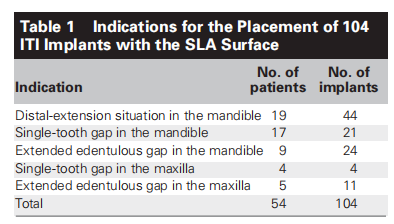Purpose: The aim of this study was to evaluate the success rate of ITI implants with the SLA surface that were loaded after 6 weeks of healing. Materials and Methods: In this prospective cohort study, a total of 104 implants were placed in posterior sites of 51 partially edentulous patients exhibiting bone densities of Class 1, 2, or 3. After a healing period of 6 weeks, all implants were functionally loaded with cemented crowns or fixed partial dentures. The patients were recalled at 3, 12, 24, and 36 months for clinical and radiographic examination. Results: One implant failed to integrate during healing, and 1 implant was lost to follow-up and considered a dropout. The remaining 102 implants showed favorable clinical and radiographic findings and were considered successfully integrated at the 3-year examination. This resulted in a 3-year success rate of 99.03%. Discussion: The peri-implant soft tissues were stable over time, as evidenced by no changes in the mean probing depths and the mean attachment levels during the follow-up period. None of the radiographs exhibited signs of continuous peri-implant radiolucency, which confirmed ankylotic stability of all 102 implants. The radiographic evaluation of the bone level at the implant indicated stability of the bone crest levels. Conclusion: The results of this prospective study demonstrated that early loading of ITI implants with the SLA surface after an unloaded healing period of 6 weeks provided successful tissue integration with high predictability, and that successful tissue integration was well maintained up to 3 years of follow-up in this study population.
Maintenance Period During the maintenance period, clinical examinations at 3 months revealed that 2 implants had developed a local peri-implant infection caused by a failure to remove excess cement following cementation of the fixed restoration. The cement was removed, and in addition, local irrigation of the peri-implant sulcus with chlorhexidine digluconate (0.1% twice a day) was prescribed. With this treatment, the peri-implant infection was successfully treated in both patients. The remaining implants were firmly anchored in bone and showed no signs of peri-implant infections and/or radiolucencies throughout the maintenanceperiod, including the implant that had turned slightly at abutment connection. In addition, all patients were free of subjective complaints. One patient did not attend the 3- and 12-month followup visits. This patient, therefore, was considered a dropout and removed from the study analysis.

by Wilke and associates19 tested removal torque values (RTV) of unloaded titanium implants with various surface characteristics in the tibiae of sheep. The SLA surface achieved RTVs exceeding 600 Ncm at 6 months of healing, while polished or fine-textured surfaces showed mean RTVs of 40 to 70 Ncm during the course of the study period. Both studies were carried out in the femora and/or tibiae of miniature pigs or sheep; hence, there was a need to examine this promising SLA surface in jawbone prior to clinical testing in patients. The advantages of the SLA surface, in comparison to the TPS surface, during the initial healing period were then confirmed in a histometric study in the canine mandible20 and in a biomechanical study measuring the RTV of 8-mm-long implants in the maxillae of miniature pigs.21 The osteophilic properties of the SLA surface were also confirmed in a series of in vitro studies examining various titanium surfaces in tissue cultures with osteoblast-like cells.22–25 The biomechanical study by Buser and associates21 demonstrated for the SLA surface a mean RTV approximating 140 Ncm at 4 weeks of healing. This value led to the possibility of reducing the standard healing period of 3 months that had been used with ITI implants in patients for more than 20 years. Thus, it was decided to test SLA implants in an international multicenter study with an initiation of loading as early as 6 weeks. The present report documents the 3-year results of this prospective study at the University of Berne, where SLA implants were tested exclusively in posterior sites in partially edentulous patients. The tested hypothesis was that SLA implants would achieve a success rate similar to that reported in previous clinical studies for ITI implants with a TPS surface.
上一篇: 旋涂金属氧化物及其在下一代光刻中的应用
下一篇: 改善微纳米结构光学元件的性能